Saint Lucia Volcanoes
Saint Lucia has 1 Holocene volcanoes. Note that as a scientific organization we provide these listings for informational purposes only, with no international legal or policy implications. Volcanoes will be included on this list if they are within the boundaries of a country, on a shared boundary or area, in a remote territory, or within a maritime Exclusive Economic Zone. Bolded volcanoes have erupted within the past 20 years. Suggestions and data updates are always welcome ().
| Volcano Name | Location | Last Eruption | Primary Volcano Type |
|---|---|---|---|
| Qualibou | St. Lucia | 1766 CE | Caldera |
Chronological listing of known Holocene eruptions (confirmed or uncertain) from volcanoes in Saint Lucia. Bolded eruptions indicate continuing activity.
| Volcano Name | Start Date | Stop Date | Certainty | VEI | Evidence |
|---|---|---|---|---|---|
| Qualibou | 1766 | Unknown | Confirmed | 1 | Observations: Reported |
Saint Lucia has 0 Pleistocene volcanoes. Note that as a scientific organization we provide these listings for informational purposes only, with no international legal or policy implications. Volcanoes will be included on this list if they are within the boundaries of a country, on a shared boundary or area, in a remote territory, or within a maritime Exclusive Economic Zone. Suggestions and data updates are always welcome ().
There are 7 photos available for volcanoes in Saint Lucia.
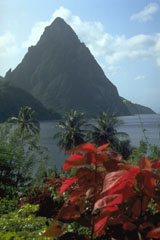 The steep-sided pyramid of the Petit Piton lava dome, the northernmost of St. Lucia's renowned Pitons, rises to the south above Soufriere Bay. The dramatic peak is the eroded plug of a dacitic dome that was emplaced about 250,000 years ago. The 743-m-high dome displays nearly vertical flow banding on all sides. Emplacement of the Pitons preceded formation of the Qualibou caldera about 32-39,000 years ago.
The steep-sided pyramid of the Petit Piton lava dome, the northernmost of St. Lucia's renowned Pitons, rises to the south above Soufriere Bay. The dramatic peak is the eroded plug of a dacitic dome that was emplaced about 250,000 years ago. The 743-m-high dome displays nearly vertical flow banding on all sides. Emplacement of the Pitons preceded formation of the Qualibou caldera about 32-39,000 years ago.Photo by Lee Siebert, 1991 (Smithsonian Institution).
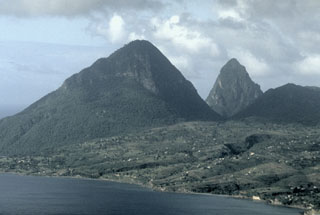 The Pitons, the dramatic landmarks of the island of St. Lucia, are the eroded plugs of two Pleistocene lava domes. Gros Piton (left) and the even steeper Petit Piton (right) are pre-caldera lava domes west and SW of the late-Pleistocene Qualibou caldera. The lower ridge in the right foreground is the SW-most of the 3 Bois d'Indie Franciou andesitic lava domes. They were constructed along a NE-trending fault.
The Pitons, the dramatic landmarks of the island of St. Lucia, are the eroded plugs of two Pleistocene lava domes. Gros Piton (left) and the even steeper Petit Piton (right) are pre-caldera lava domes west and SW of the late-Pleistocene Qualibou caldera. The lower ridge in the right foreground is the SW-most of the 3 Bois d'Indie Franciou andesitic lava domes. They were constructed along a NE-trending fault.Photo by Lee Siebert, 1991 (Smithsonian Institution).
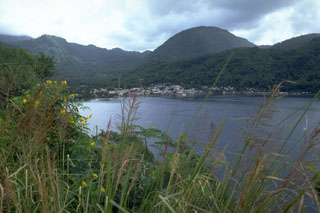 The town of Soufriere lies just NW of the 10-km-wide Qualibou caldera. This view from the NW looks across Soufriere Bay to the rounded Terre Blanche lava dome. The western caldera wall lies between the dome and the gentle ridge behind the town. The ridge in the background to the left of Terre Blanche is the back wall of the 3.5 x 5 km caldera, which was formed during powerful eruptions about 32-39,000 years ago.
The town of Soufriere lies just NW of the 10-km-wide Qualibou caldera. This view from the NW looks across Soufriere Bay to the rounded Terre Blanche lava dome. The western caldera wall lies between the dome and the gentle ridge behind the town. The ridge in the background to the left of Terre Blanche is the back wall of the 3.5 x 5 km caldera, which was formed during powerful eruptions about 32-39,000 years ago.Photo by Lee Siebert, 1991 (Smithsonian Institution).
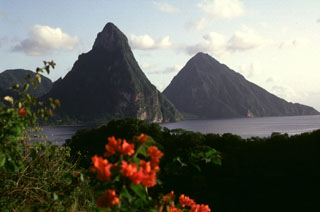 The twin lava domes of the Pitons rise above Soufriere Bay on St. Lucia, forming one of the scenic highlights of the West Indies. Petit Piton (left) and Gros Piton (right) are the eroded plugs of 250,000-year-old dacitic lava domes preceding formation of the 3.5 x 5 km Qualibou caldera about 32-39,000 years ago. The only known Holocene activity at Qualibou was a minor phreatic eruption in the Sulfur Springs thermal area in 1766 CE that ejected a thin ash layer over a wide area.
The twin lava domes of the Pitons rise above Soufriere Bay on St. Lucia, forming one of the scenic highlights of the West Indies. Petit Piton (left) and Gros Piton (right) are the eroded plugs of 250,000-year-old dacitic lava domes preceding formation of the 3.5 x 5 km Qualibou caldera about 32-39,000 years ago. The only known Holocene activity at Qualibou was a minor phreatic eruption in the Sulfur Springs thermal area in 1766 CE that ejected a thin ash layer over a wide area. Photo by Lee Siebert, 1991 (Smithsonian Institution).
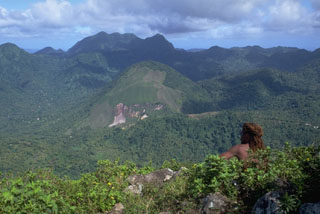 The rounded Terre Blanche lava dome (center) was constructed within the 3.5 x 5 km wide Qualibou caldera. The dome is seen here from the summit of Petit Piton, a pre-caldera lava dome, with the skyline ridge forming the NE caldera wall. Andesitic lava flows and breccias are exposed in the caldera wall. The 450-m-high Terre Blanche dome is one of 3 dacitic lava domes that grew following formation of the caldera about 39,000 years ago.
The rounded Terre Blanche lava dome (center) was constructed within the 3.5 x 5 km wide Qualibou caldera. The dome is seen here from the summit of Petit Piton, a pre-caldera lava dome, with the skyline ridge forming the NE caldera wall. Andesitic lava flows and breccias are exposed in the caldera wall. The 450-m-high Terre Blanche dome is one of 3 dacitic lava domes that grew following formation of the caldera about 39,000 years ago.Photo by Lee Siebert, 1991 (Smithsonian Institution).
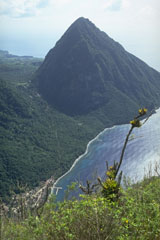 Gros Piton, seen here from the summit of the Petit Piton, is the southernmost of the twin lava domes that are the hallmark of the island of St. Lucia. The 777-m high and 3-km wide dacitic dome was erupted about 260,000 years ago. Rocks of a small tuff ring are exposed at its base.
Gros Piton, seen here from the summit of the Petit Piton, is the southernmost of the twin lava domes that are the hallmark of the island of St. Lucia. The 777-m high and 3-km wide dacitic dome was erupted about 260,000 years ago. Rocks of a small tuff ring are exposed at its base.Photo by Lee Siebert, 1991 (Smithsonian Institution).
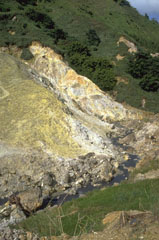 Hydrothermally altered rocks are exposed over a wide area in the Sulphur Springs thermal area of Qualibou volcano. The thermal area, located in a valley SW of Terre Blanche lava dome, contains 11 hot pools, some of which occasionally produce small steam-driven fountains about 1-m high. Sulphur Springs was the site in 1766 of the only historical eruption of Qualibou. A small explosion deposited ash and cinders over a wide area.
Hydrothermally altered rocks are exposed over a wide area in the Sulphur Springs thermal area of Qualibou volcano. The thermal area, located in a valley SW of Terre Blanche lava dome, contains 11 hot pools, some of which occasionally produce small steam-driven fountains about 1-m high. Sulphur Springs was the site in 1766 of the only historical eruption of Qualibou. A small explosion deposited ash and cinders over a wide area.Photo by Lee Siebert, 1991 (Smithsonian Institution).
This is a compilation of Saint Lucia volcano information sources, such as official monitoring or other government agencies.
| Volcanic Ash Advisory Center | |
|---|---|
| Washington Volcanic Ash Advisory Center (VAAC) | |
| - Washington VAAC Archive | |
| - Washington VAAC Notices | |



